ZENON, a novel POZ Kruppel-like DNA binding protein associated with differentiation and/or survival of late postmitotic neurons
- PMID: 15713629
- PMCID: PMC549352
- DOI: 10.1128/MCB.25.5.1713-1729.2005
ZENON, a novel POZ Kruppel-like DNA binding protein associated with differentiation and/or survival of late postmitotic neurons
Abstract
The rat tyrosine hydroxylase gene promoter contains an E-box/dyad motif and an octameric and heptameric element that may be recognized by classes of transcription factors highly expressed during nervous system development. In a one-hybrid genetic screen, we used these sites as targets to isolate cDNAs encoding new transcription factors present in the brain. We identified ZENON, a novel rat POZ protein that contains two clusters of Kruppel-like zinc fingers and that presents several features of a transcription factor. ZENON is found in nuclei following transient transfection with the cDNA. The N-terminal zinc finger cluster contains a DNA binding domain that interacts with the E box. Cotranfection experiments revealed that ZENON induces tyrosine hydroxylase promoter activity. Unlike other POZ proteins, the ZENON POZ domain is not required for either activation of transcription or self-association. In the embryonic neural tube, ZENON expression is restricted to neurons that have already achieved mitosis and are engaged in late stages of neuronal differentiation (late postmitotic neurons). ZENON neuronal expression persists in the adult brain; therefore, ZENON can be considered a marker of mature neurons. We propose that ZENON is involved in the maintenance of panneuronal features and/or in the survival of mature neurons.
Figures
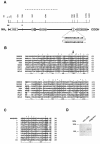
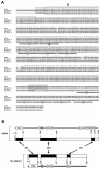




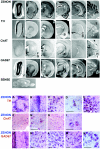
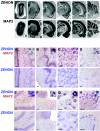
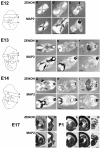

Similar articles
-
Expression of the Krüppel-type zinc finger protein rKr2 in the developing nervous system.Glia. 2001 Apr 15;34(2):110-20. doi: 10.1002/glia.1046. Glia. 2001. PMID: 11307160
-
Cloning and functional characterization of Roaz, a zinc finger protein that interacts with O/E-1 to regulate gene expression: implications for olfactory neuronal development.J Neurosci. 1997 Jun 1;17(11):4159-69. doi: 10.1523/JNEUROSCI.17-11-04159.1997. J Neurosci. 1997. PMID: 9151733 Free PMC article.
-
The LAZ3/BCL6 oncogene encodes a sequence-specific transcriptional inhibitor: a novel function for the BTB/POZ domain as an autonomous repressing domain.Cell Growth Differ. 1995 Dec;6(12):1495-503. Cell Growth Differ. 1995. PMID: 9019154
-
SAG/ROC/Rbx/Hrt, a zinc RING finger gene family: molecular cloning, biochemical properties, and biological functions.Antioxid Redox Signal. 2001 Aug;3(4):635-50. doi: 10.1089/15230860152542989. Antioxid Redox Signal. 2001. PMID: 11554450 Review.
-
Nervous system regulated by POZ domain Krüppel-like zinc finger (POK) family transcription repressor RP58.Br J Pharmacol. 2021 Feb;178(4):813-826. doi: 10.1111/bph.15265. Epub 2020 Dec 7. Br J Pharmacol. 2021. PMID: 32959890 Review.
Cited by
-
Context-dependent CpG methylation directs cell-specific binding of transcription factor ZBTB38.Epigenetics. 2022 Dec;17(13):2122-2143. doi: 10.1080/15592294.2022.2111135. Epub 2022 Aug 24. Epigenetics. 2022. PMID: 36000449 Free PMC article.
-
A family of human zinc finger proteins that bind methylated DNA and repress transcription.Mol Cell Biol. 2006 Jan;26(1):169-81. doi: 10.1128/MCB.26.1.169-181.2006. Mol Cell Biol. 2006. PMID: 16354688 Free PMC article.
-
The methyl-CpG-binding protein CIBZ suppresses myogenic differentiation by directly inhibiting myogenin expression.Cell Res. 2011 Nov;21(11):1578-90. doi: 10.1038/cr.2011.90. Epub 2011 May 31. Cell Res. 2011. PMID: 21625269 Free PMC article.
-
Modifiers and Readers of DNA Modifications and Their Impact on Genome Structure, Expression, and Stability in Disease.Front Genet. 2016 Jun 21;7:115. doi: 10.3389/fgene.2016.00115. eCollection 2016. Front Genet. 2016. PMID: 27446199 Free PMC article. Review.
-
Role of ZBTB38 Genotype and Expression in Growth and Response to Recombinant Human Growth Hormone Treatment.J Endocr Soc. 2022 Jan 18;6(3):bvac006. doi: 10.1210/jendso/bvac006. eCollection 2022 Mar 1. J Endocr Soc. 2022. PMID: 35178492 Free PMC article.
References
-
- Albagli, O., P. Dhordain, C. Deweindt, G. Lecocq, and D. Leprince. 1995. The BTB/POZ domain: a new protein-protein interaction motif common to DNA- and actin-binding proteins. Cell Growth Differ. 6:1193-1198. - PubMed
-
- Albagli-Curiel, O. 2003. Ambivalent role of BCL6 in cell survival and transformation. Oncogene 22:507-516. - PubMed
-
- Albanèse, V., N. F. Biguet, H. Kiefer, E. Bayard, J. Mallet, and R. Meloni. 2001. Quantitative effects on gene silencing by allelic variation at a tetranucleotide microsatellite. Hum. Mol. Genet. 10:1785-1792. - PubMed
-
- Altschul, S. F., W. Gish, W. Miller, E. W. Myers, and D. J. Lipman. 1990. Basic local alignment search tool. J. Mol. Biol. 215:403-410. - PubMed
Publication types
MeSH terms
Substances
LinkOut - more resources
Full Text Sources
Molecular Biology Databases
